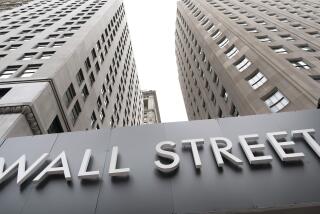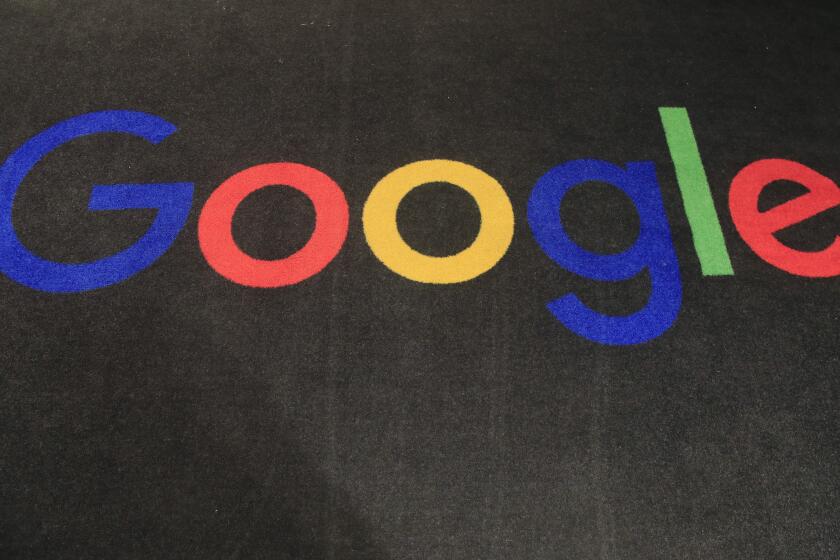Stock market suffers worst one-day drop since 2008
- Share via
U.S. investors haven’t seen stocks fall so far and fast in years.
Friday’s implosion could suggest the end of one of the longest bull markets in history, one marked by low interest rates, confident investors and soaring corporate valuations — despite an often jittery global economy.
The recent trouble in China’s economy, analysts say, only ignited a long-smoldering bonfire.
“It came in a flash but what was behind it was building,” said James W. Paulsen, chief investment strategist at Wells Capital Management. Investors had grown complacent, he said, “and complacency is never good.”
The Dow Jones industrial average fell 530.94 points on Friday, or 3.1%, to close at 16,459.75. That’s down 10.1% from an earlier peak in May. The Standard & Poor’s 500 index has dropped 7.5% in the last three months.
The drop was the biggest for the Dow since Aug. 8, 2011, when it fell 634.76 points.
Still, the overdue correction could end up resetting markets in ways that ultimately benefit most investors, analysts said. The correction — known on Wall Street as a decline of at least 10% — may serve to check investor sentiment and expectations, forcing investors to start behaving more rationally.
The drop could provide buying opportunities for stocks at lower prices, said Robert Keiser, vice president of macroeconomic research at S&P Capital IQ’s Global Markets Intelligence unit.
“What we’re witnessing here is a reassessment of risk,” he said, potentially aligning valuations with underlying earnings and potential.
Even in an era of increasing volatility, companies with strong fundamentals will weather storms.
“If they are good quality stocks and trading at a good valuation, you don’t need to fear tremendous downsides,” Keiser said.
But markets don’t also behave rationally, and analysts feared panic selling could trigger more big losses next week.
“The question now: Is it over?” Paulsen said. “My suspicion is no.”
Friday’s downturn was broad, affecting nearly every sector. The S&P 500 slid 3.2% to 1,970.89. The Nasdaq composite, which has a lot of technology stocks, dropped 3.5% to 4,706.04. All three major U.S. indexes are in the red this year.
Investor anxiety will have ripple effects across the California technology industry, particularly those preparing initial public offerings, analysts said. Tech firms expected to go public over the next two years, such as Airbnb, Snapchat and Uber, could either rush their IPOs before the market slides further or hit pause on plans to go public.
Technology stocks are already feeling the crunch. The Standard & Poor’s tech index for North America dropped 3.9% on Friday, and was down 8.6% from its 52-week high. Shares of Apple dropped 6.1% to $105.76, Netflix plunged 7.6% to $103.96 and Microsoft slid 5.7% to $43.07.
“Technology was one of the better performing sectors through July,” said David Schiegoleit, managing director of investment for the Private Client Reserve at U.S. Bank. But market sell-offs often punish the winners, he said, as investors sell successful stocks to lock in gains.
The turbulence is likely to continue until the Federal Reserve decides in September whether to raise interest rates.
In minutes released this week, the Fed sent mixed signals about whether it will bump up rates for the first time in nearly a decade.
After the rout, some economists are predicting that the Fed will hold off on raising its benchmark rate, possibly until next year.
“Raising interest rates in September would make the situation worse,” said Sung Won Sohn, an economist at Cal State Channel Islands. “There’s a lot of fear in the marketplace, and one of the main fears is the potential hike.”
That anxiety comes after the U.S. market enjoyed 47 months without a decline of at least 10%, compared with a historic average of 18 months, said Sam Stovall, U.S. equity strategist at S&P Capital IQ. The bull market has lasted more than six years, while the average is 41/2 years, he said.
“Investors are no better than hyperactive first-graders playing musical chairs,” Stovall said. They are “always trying to anticipate when the music will stop.”
Stovall said dumping stocks could backfire if the market rallies.
The U.S. market has lived through 19 corrections since World War II, he said. On average, the market has taken four months to recover.
“From the economics standpoint, the U.S. is pretty sound,” said Scott Anderson, chief economist of the Bank of the West.
Anxiety about a slowdown in China’s economy has fueled much of the volatility.
Last week, the Chinese government devalued its currency, known as the yuan or renminbi, after its stock market suffered huge drops in the last two months.
On Friday, markets were spooked again when a preliminary version of a gauge of the manufacturing sector, the Caixin purchasing managers’ index, fell to a 77-month low of 47.1 in August. On a 100-point scale, any number below 50 signals contraction.
Other concerns include a drop in crude-oil prices to a six-year low and potential fallout from Greece’s debt crisis.
Greek Prime Minister Alexis Tsipras resigned Thursday after Greece narrowly avoided defaulting on its debt by using funds from its latest bailout package to make a payment to the European Central Bank.
“We’re going to see volatility for a while,” Anderson said. “The markets are on a razor’s edge in terms of economic data. Every piece of data is going to get scrutinized, and probably over-analyzed.”
shan.li@latimes.com
Twitter: @ByShanLi
andrea.chang@latimes.com
Twitter: @byandreachang
paresh.dave@latimes.com
Twitter: @peard33
More to Read
Inside the business of entertainment
The Wide Shot brings you news, analysis and insights on everything from streaming wars to production — and what it all means for the future.
You may occasionally receive promotional content from the Los Angeles Times.













